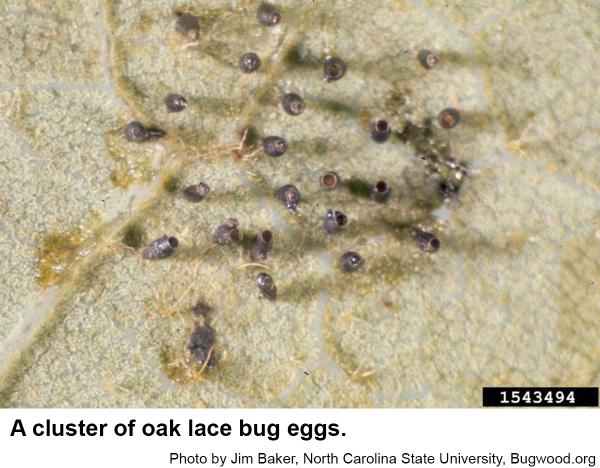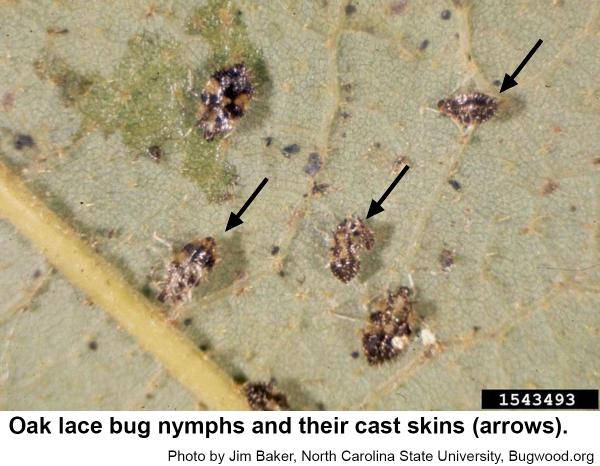Description and Biology
The oak lace bug, Corythucha arcuata, is an occasional pest of oaks in the landscape. Adults are 1/8 inch long and tan with darker brown spots. Veins divide the wings and extensions of the thorax into tiny polygons that resemble lace. Lateral extensions of the thorax give the oak lace bug an almost rectangular outline in top view. Oak lace bug nymphs are smaller than adults and are mottled and spiny. Each female lays her eggs on the lower leaf surface in groups of 25 to about 50. Each minute egg is dark brown and shaped like a conga drum. Tiny nymphs hatch and feed together as they grow and molt four times before maturing. Several generations occur each year. Adults overwinter in sheltered areas of bark or in other crevices.
Host Plants
Oaks, especially white oak and burr oak are host plants of this lace bug. Oak lace bugs feed on the lower leaf surface and cause yellow or pale spots to appear on the upper leaf surface. This damage is somewhat like thrips injury, but lace bug injury is coarser. Lace bugs also leave "fly specks" or excrement on the lower leaf surface (this is one way to tell lace bug damage from spider mite damage - spider mites don't leave noticeable "fly specks"). If much feeding occurs, the leaves may become almost bleached out. Oak lace bugs are reported to cause leaf curl and premature leaf drop when they are abundant.
Residential Recommendations
Lace bugs are relatively difficult to control. Although the leaf damage caused by oak lace bugs may be alarming, pesticide treatment is usually not necessary. If the infested tree is small enough to treat and if it is of high value to the landscape, most of the pesticides labeled for landscape use should give adequate control if applied thoroughly.
References
- Lace Bug on Deciduous Woody Ornamental Plants. Hoover, G.A., Sr. 2002. Insect Advice from Extension. PennState College of Agr. Sci. Dept. Entomology.
- Lace Bugs, Frank, S. D. and S. Bambara. 2009 (revised). Entomology Insect Notes. NC State Extension Publications.
- Lace Bugs. Lloyd J. E. and J. Hahn. 2018. Yard and garden insects. University of Minnesota Extension.
- Oak Lace Bug Symptoms Have Bark, But They Have Little Bite. Rettke, S. K. 2013. Plant & Pest Advisory, Rutgers University, New Jersey Agricultural Experiment Station, Rutgers Cooperative Extension.
- The lace bugs (Hemiptera: Tingidae) of North Carolina and their hosts. Horn, K. F., C. G. Wright, and M. H. Farrier. 1979. North Carolina Agr. Exp. Esta. Tech. Bull. 257. 22 pp.
- Insect and Related Pests of Shrubs. Baker, J. R. ed. 1980. NC Agr. Extension Service pub. AG-189. 199 pp.
- Extension Plant Pathology Publications and Factsheets
- Horticultural Science Publications
- North Carolina Agricultural Chemicals Manual
For assistance with a specific problem, contact your local Cooperative Extension Center.
This Factsheet has not been peer reviewed.
Publication date: July 21, 2016
Reviewed/Revised: Oct. 7, 2019
Recommendations for the use of agricultural chemicals are included in this publication as a convenience to the reader. The use of brand names and any mention or listing of commercial products or services in this publication does not imply endorsement by NC State University or N.C. A&T State University nor discrimination against similar products or services not mentioned. Individuals who use agricultural chemicals are responsible for ensuring that the intended use complies with current regulations and conforms to the product label. Be sure to obtain current information about usage regulations and examine a current product label before applying any chemical. For assistance, contact your local N.C. Cooperative Extension county center.
N.C. Cooperative Extension prohibits discrimination and harassment regardless of age, color, disability, family and marital status, gender identity, national origin, political beliefs, race, religion, sex (including pregnancy), sexual orientation and veteran status.




